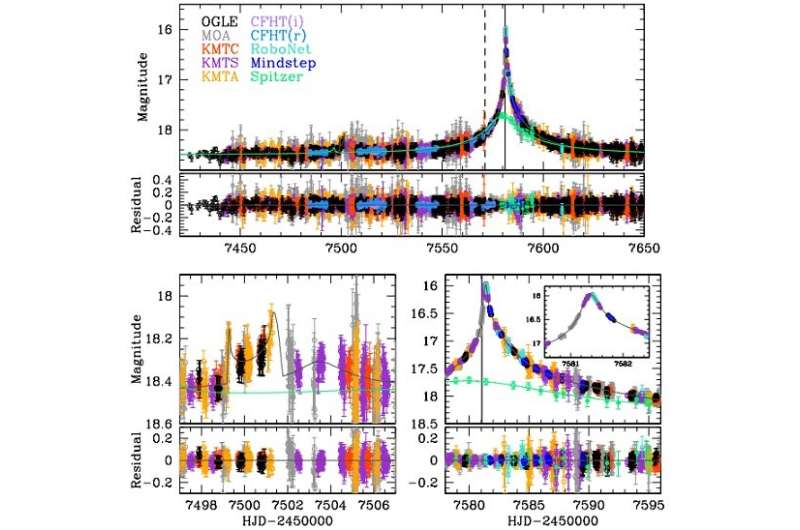November 6, 2017 report
Extremely massive exoplanet discovered in the Milky Way's bulge

(Phys.org)—As a result of NASA's Spitzer Space Telescope observations of a microlensing event, astronomers have found an extremely massive alien world circling a star located in the Milky Way's bulge. The newly discovered planet, designated OGLE-2016-BLG-1190Lb, is the first Spitzer microlensing exoworld residing in the galactic bulge. The finding was presented October 27 in a paper published on arXiv.org.
Microlensing is very useful technique for detecting alien worlds in the inner galactic disk and bulge, where it is difficult to search for planets with other methods. It facilitates the discovery of distant objects by using background stars as flashlights. If a star moves in front of an another star, the light from the distant star is bent by the gravitational pull of the nearer star and the more distant star is magnified. Microlensing does not rely on the light from the host stars; thus, it can detect planets, even when the host stars cannot be detected.
OGLE-2016-BLG-1190 was discovered in June 2016 as a microlensing event by the Optical Gravitational Lensing Experiment (OGLE) collaboration. OGLE is a Polish astronomical project based at the University of Warsaw, searching for dark matter and extrasolar planets. It utilizes the 1.3 meter Warsaw telescope mounted at the Las Campanas observatory in Chile.
Spitzer observed this microlensing event a few days after its discovery. An international team of researchers led by Yoon-Hyun Ryu of the Korea Astronomy and Space Science Institute in Daejon, South Korea, reports that these Spitzer observations detected a new, massive planet orbiting a dwarf star.
"We report the discovery of OGLE-2016-BLG-1190Lb, which is likely to be the first Spitzer microlensing planet in the galactic bulge/bar, an assignation that can be confirmed by two epochs of high-resolution imaging of the combined source-lens baseline object," the astronomers wrote in the paper.
According to the study, OGLE-2016-BLG-1190Lb appears to be an extremely massive planet with a mass of about 13.4 Jupiter masses. Such high mass puts the object right at the deuterium burning limit—the conventional boundary between planets and brown dwarfs. Therefore, the researchers do not exclude the possibility that the newly found planet could be a low-mass brown dwarf.
OGLE-2016-BLG-1190Lb orbits its parent star approximately every three years at a distance of about 2.0 AU. The host is a G dwarf with a mass of 0.89 solar masses. The system is located some 22,000 light years away from the Earth.
The authors of the paper emphasize that OGLE-2016-BLG-1190Lb is the first exoplanet discovered thanks to microlensing and the Spitzer spacecraft. Moreover, what makes this planet remarkable is that it is right at the edge of the so-called brown dwarf desert, what raises questions about whether such objects are really planets or failed stars.
"Since the existence of the brown dwarf desert is the signature of different formation mechanisms for stars and planets, the extremely close proximity of OGLE-2016-BLG-1190Lb to this desert raises the question of whether it is truly a 'planet' (by formation mechanism) and therefore reacts back upon its role tracing the galactic distribution of planets," the paper reads.
More information: OGLE-2016-BLG-1190Lb: First Spitzer Bulge Planet Lies Near the Planet/Brown-Dwarf Boundary, arXiv:1710.09974 [astro-ph.EP] arxiv.org/abs/1710.09974
Abstract
We report the discovery of OGLE-2016-BLG-1190Lb, which is likely to be the first Spitzer microlensing planet in the Galactic bulge/bar, an assignation that can be confirmed by two epochs of high-resolution imaging of the combined source-lens baseline object. The planet's mass M_p= 13.4+-0.9 M_J places it right at the deuterium burning limit, i.e., the conventional boundary between "planets" and "brown dwarfs". Its existence raises the question of whether such objects are really "planets" (formed within the disks of their hosts) or "failed stars" (low mass objects formed by gas fragmentation). This question may ultimately be addressed by comparing disk and bulge/bar planets, which is a goal of the Spitzer microlens program. The host is a G dwarf M_host = 0.89+-0.07 M_sun and the planet has a semi-major axis a~2.0 AU. We use Kepler K2 Campaign 9 microlensing data to break the lens-mass degeneracy that generically impacts parallax solutions from Earth-Spitzer observations alone, which is the first successful application of this approach. The microlensing data, derived primarily from near-continuous, ultra-dense survey observations from OGLE, MOA, and three KMTNet telescopes, contain more orbital information than for any previous microlensing planet, but not quite enough to accurately specify the full orbit. However, these data do permit the first rigorous test of microlensing orbital-motion measurements, which are typically derived from data taken over <1% of an orbital period.
© 2017 Phys.org





















